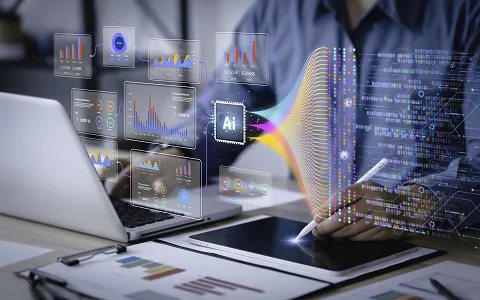Quantzig is the expert in AI Advanced Analytics Service Providers, delivering customized solutions that drive digital transformation and data-driven decision-making. With a focus on Responsible AI, Data Engineering, and Predictive Analytics, Quantzig leverages advanced technologies to optimize operations across industries, ensuring ethical AI practices and data analytics consulting while enhancing sales performance tracking, customer segmentation, and supply chain efficiency. Our innovative approach ensures impactful, tailored results.
Quantzig excels in Advanced Analytics for marketing, utilizing AI, Data Visualization, and Business Intelligence to enhance strategies. We integrate Intelligent Document Retrieval and Predictive Analytics for ethical, data-driven insights, boosting sales and optimizing customer segmentation.
Learn more about AI for MarketingQuantzig excels in Advanced Analytics for supply chain management, leveraging AI and Data Engineering to optimize operations. We tackle challenges like Data Swamp and Silos with solutions such as Azure Cognitive Services and ML, enhancing efficiency through robust Data Visualization and Model Management.
Learn more about AI for Supply ChainIn Advanced Analytics for manufacturing, Quantzig uses AI to boost efficiency and optimize processes. We leverage data strategy and AI/ML services for improved insights and performance. Our approach integrates model management with data engineering, predictive analytics, and data visualization to support digital transformation.
Learn more about AI for Manufacturing OPSQuantzig leads in Generative AI, using AI/ML services and data engineering for innovative solutions. We excel in data visualization and automated invoice data extraction for data-driven decisions, integrating model management and maintenance for evolving AI models, fostering digital transformation and responsible AI practices.
Learn more about Generative AIQuantzig’s ML Ops services integrate advanced analytics with AI for seamless model deployment and management. We use data engineering and management to optimize model maintenance. Our AI development and automated invoice data extraction boost efficiency, supporting data-driven decisions while prioritizing responsible AI and digital transformation.
Learn more about ML OpsAt Quantzig, we leverage AI Advanced Analytics Service Providers and AI to drive digital transformation and data-driven decision-making. Our solutions are meticulously crafted with Responsible AI principles, ensuring ethical and trustworthy outcomes. By integrating seamlessly with your existing systems, we offer a custom approach to every business need, combining AI for analytics and Data Engineering to deliver actionable insights. With expertise in artificial intelligence and data analytics, we develop artificial intelligence platforms that enhance business performance. Our Data Management solutions, powered by artificial intelligence data, optimize processes, create predictive models, and deliver impactful results. We excel in Advanced Analytics and Artificial Intelligence, using artificial intelligence and analytics to transform complex data into clear, actionable insights that help organizations unlock their full potential.

Empower your businesses to stay competitive by leveraging AI-driven decision support and data insights for operational and strategic excellence. Our approach includes modernizing data layers, providing real-time intelligence, optimizing processes, and enabling strategic actions. Download our Ai & Advanced Analytics guide today!
Download Now